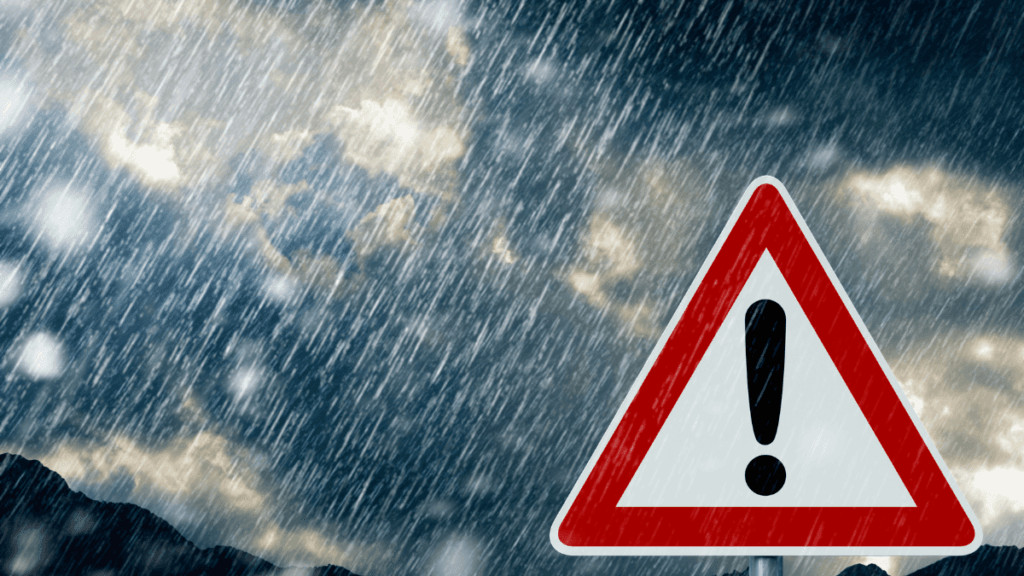Johannesburg and surrounding areas in Gauteng are currently facing a Severe Thunderstorm Warning, with emergency services on high alert in Ekurhuleni. The South African Weather Service (SAWS) has issued this warning due to the risk of heavy rainfall, strong winds, and hail that could lead to flash floods and damage to property.
As mop-up operations continue in affected areas, residents are urged to remain vigilant and take necessary precautions to ensure their safety. This article provides detailed information about the Severe Thunderstorm Warning, how to prepare, and what to do before, during, and after a storm.
What is a Severe Thunderstorm Warning?
A Severe Thunderstorm Warning is issued when a thunderstorm is expected to bring extreme weather conditions that may threaten lives and property. The warning is based on the presence of:
- Heavy Rainfall: Leading to flooding in low-lying areas.
- Strong Winds: Capable of uprooting trees and damaging structures.
- Hailstorms: Which can damage vehicles, roofs, and crops.
- Frequent Lightning: Increasing the risk of fires and electrocution.
The SAWS monitors weather patterns closely and issues Severe Thunderstorm Warnings to alert the public. These warnings are broadcasted through various media, including radio, television, and online platforms.
Recent Severe Thunderstorm Warning for Johannesburg
Recently, a Severe Thunderstorm Warning was issued for Johannesburg and surrounding areas, prompting emergency teams to take action. Eric Maloka, a spokesperson for the City’s Disaster and Emergency Management, stated that response teams are actively monitoring all incidents.
Residents in affected areas, especially in Ekurhuleni, have already experienced flooding and infrastructure damage. The authorities have urged people to stay indoors and avoid unnecessary travel. More storms are expected, making it crucial for everyone to be prepared.
How to Stay Safe During a Severe Thunderstorm Warning
1. Stay Updated on Weather Alerts
During a Severe Thunderstorm Warning, it is important to stay informed about the latest weather conditions. Here’s how you can keep track:
- Tune in to local radio stations for weather updates.
- Follow SAWS on social media for live alerts.
- Use weather tracking apps for real-time storm monitoring.
Being aware of the storm’s progression allows you to take appropriate action and avoid being caught in hazardous conditions.
2. Seek Shelter Immediately
If a Severe Thunderstorm Warning has been issued, seek shelter indoors as soon as possible. Here’s what to do:
- At home: Close all windows and doors securely. Avoid using electrical appliances, as lightning can cause power surges.
- If outside: Move to a safe indoor location immediately. Avoid taking shelter under trees, as they can attract lightning.
- If driving: Pull over in a safe location away from trees and power lines. Stay inside the vehicle and turn on hazard lights.
3. Avoid Flooded Areas
Heavy rainfall associated with a Severe Thunderstorm Warning can lead to flash flooding. Follow these precautions:
- Do not walk or drive through flooded roads, as water levels can rise rapidly.
- If your vehicle gets stuck in water, exit immediately and move to higher ground.
- Stay away from rivers, lakes, and drainage systems, as they may overflow.
4. Secure Outdoor Objects
Strong winds during a Severe Thunderstorm Warning can turn loose objects into dangerous projectiles. Before the storm hits:
- Secure outdoor furniture, umbrellas, and trash bins.
- Park vehicles in garages or covered areas to protect them from hail.
- Bring pets indoors to ensure their safety.
5. Unplug Electrical Appliances
Lightning strikes can cause power surges that damage electronics. To prevent this:
- Unplug televisions, computers, and other electrical appliances.
- Avoid using landline telephones during a thunderstorm.
- Have backup battery power or a generator in case of power outages.
6. Stay Away from Windows and Doors
During a Severe Thunderstorm Warning, move to the safest area in your home:
- Stay away from windows and glass doors to prevent injuries from shattered glass.
- Find an interior room, such as a bathroom or basement, where you can take shelter.
7. Prepare an Emergency Kit
Every household should have an emergency kit ready during a Severe Thunderstorm Warning. Your kit should include:
- Bottled water and non-perishable food.
- A flashlight with extra batteries.
- A fully charged power bank.
- A first aid kit and necessary medications.
- Important documents stored in waterproof containers.
What to Do After a Severe Thunderstorm Warning
Once the storm has passed, take the following steps:
1. Check for Updates
Continue to follow weather updates to ensure the storm has fully cleared. Sometimes, Severe Thunderstorm Warnings are extended if more storms are expected.
2. Watch Out for Hazards
- Avoid fallen power lines and report them to the authorities.
- Be cautious of loose debris or unstable structures.
- Stay away from flooded areas, as hidden dangers like open drains or electrical currents may be present.
3. Inspect Your Home for Damage
After a Severe Thunderstorm Warning, carefully inspect your home:
- Look for roof leaks, broken windows, and structural damage.
- If you suspect gas leaks or electrical damage, call a professional before entering the house.
- Take photos of any damage for insurance claims.
4. Help Your Neighbors
If it is safe, check on your neighbors, especially the elderly and those with disabilities. Community support is crucial during recovery efforts.
5. Report Emergencies
If you need assistance due to storm-related damage, contact local emergency services:
- Ekurhuleni Disaster Management: 011 458 0911
- City of Johannesburg Emergency Services: 10177
- National Weather Service Hotline: 012 367 6000
Related: Stay Safe in Heavy Rains: Essential Flood Safety Tips for Everyone
A Severe Thunderstorm Warning is not something to take lightly. These storms can cause flooding, property damage, and pose serious risks to human lives. By staying informed, seeking shelter, and following safety guidelines, you can minimize the dangers associated with severe weather.
As Johannesburg and Ekurhuleni continue to experience storm activity, residents must remain prepared. Always follow official advisories and encourage family and friends to do the same.
Stay safe, Johannesburg!










